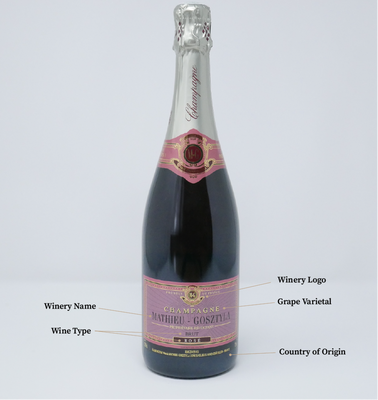Understanding What's on A Wine Label
Dec 7th 2020
 You can learn a lot about the makeup of a good bottle of wine by learning how to decipher the “language of wine” that is written on the label. Reading these labels can sometimes be confusing since the terminology can be foreign and somewhat sophisticated. The first thing to determine is if the wine is considered Old World, wines that are made in Europe, the Mediterranean, and Western Asia, or if the wine is New World, which comes from any other wine growing region, such as Napa Valley or Sonoma California. We have put together some insights to help you understand what you're reading on your wine bottle.
You can learn a lot about the makeup of a good bottle of wine by learning how to decipher the “language of wine” that is written on the label. Reading these labels can sometimes be confusing since the terminology can be foreign and somewhat sophisticated. The first thing to determine is if the wine is considered Old World, wines that are made in Europe, the Mediterranean, and Western Asia, or if the wine is New World, which comes from any other wine growing region, such as Napa Valley or Sonoma California. We have put together some insights to help you understand what you're reading on your wine bottle.
Old World Wines:
Old World wines are produced in areas where it is believed wine was first produced. These wines tend to be fresh and acidic as well as have a lower alcohol content than their modern-day counterparts. Most Old World wine labels will typically only indicate regions and aging classifications. In the past, Old World wine companies did not put the type of grapes used to make their wine, but in recent times they have begun putting them on the back label. Old World wines tend to count on the beautiful scripts and the prestige of their names written on the front labels of their bottles to make it to a wine connoisseurs table.
New World Wines:
Wines produced in newly-cultivated regions, such as the United States, South America, and Oceania usually always include basic, straight forward facts on their wine bottle labels. The front label tells you the vintage of a wine, meaning what year the grapes were harvested, which region or subregion the grapes come from, and the type of grapes that were used to make the wine. The label will likely have the aromas and flavors used to create the wine. New World wine regions are home to some of the finest vineyards in the world. The name of the vineyard, or the brand will be clearly indicated, usually in the largest type found on the front of the label. Some labels will also tell you which food the wine will pair the best with.
Government Mandates:
By law, the U.S. Government requires that every bottle of wine sold must have a label. Some of the mandated items required can be found on the back label. These include the address of the producer and the bottling company, the year the fruit was produced, and if it is a table wine, a dessert wine, or a sparkling wine. The wines net content described in milliliters and the alcohol content should both be clearly labeled on the front label. You must also put on the label that the wine contains sulfites.
After familiarizing yourself with the wines at Club Jeroboam, the major wine-producing regions and types of grapes used to make our wines, you will be able to tell from the label whether the wine will be dry or sweet, light and fruity, or full-bodied. You will be able to decide which wine will pair best with your next dinner party, be it steak, fish or chicken. At Club Jeroboam we are always ready to help you decipher the details of what is in your wine. Please contact us today to discuss our wine club membership options.

